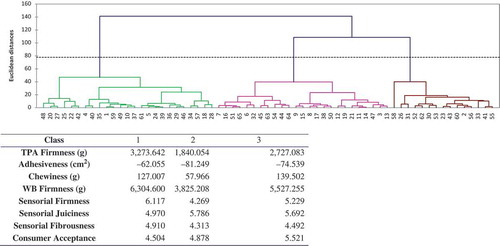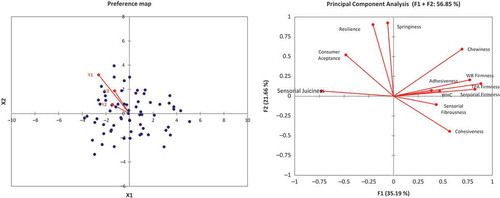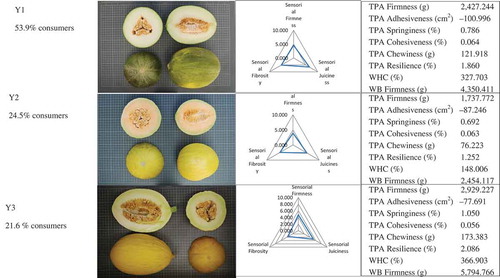Abstract
The present article deals with the relation between fruit texture and human perception in a large group of non-climacteric melon genotypes, by measuring several mechanical properties and discussing their relationship with some sensory parameters. Juiciness resulted the main factor in melon consumer acceptance, but firmness, cohesiveness, fibrousness, springiness, and resilience also defined quality groups. Consumers (53.9%) preferred a fruit of medium firmness, outstanding juiciness, and medium-high fibrousness; 24.5% of consumers have chosen a less firm fruit than the majority, while 21.6% of consumers wanted a less fibrous melon. The combination of textural traits could be larger applied in future breeding programs.
Keywords:
INTRODUCTION
Fleshy fruit texture is one of the main factors determining consumer preference.[Citation1] Desirable and undesirable quality attributes of melon fruit have already been discussed,[Citation2] and both instrumental and sensory measurements for determining some critical quality attributes have been described. Among these quality attributes, some textural parameters—such as juiciness—seem to be especially involved in consumer acceptance. And some others such as firmness and fibrousness, seem to be related to consumer rejection. Sensory firmness and juiciness are the two factors that most influence the mouthfeel of a fruit. Firmness is largely determined by the physical anatomy of the tissue, together with its turgor status. The turgor properties of a tissue or an organ are affected by factors such as the accumulation of photosynthate and the water status of the cells. Perceived juiciness is also affected by the cellular makeup of a tissue.
A large number of factors affect the texture of a plant product.[Citation3] There is a genetic influence on texture, and cultivars within a species vary significantly in these textural attributes.[Citation4] Although this is known, there is limited research describing the cultivars variation from a given species. Fruit texture is determined during ripening. This is a genetically programmed event that is characterized by a series of physiological and biochemical changes that alter fruit color, texture, firmness, aroma, and flavor, making fruit scent and flavor appealing to consumers.
The process of fruit maturation is normally viewed distinctly in climacteric and non-climacteric fruits, depending on their respiratory patterns during ripening and the logarithmic increase in the rate of ethylene production. But melon (Cucumis melo L.), which is the most diverse species of the genus Cucumis, shows climacteric as well as non-climacteric behavior depending on the cultivar or genotype. Although climacteric and non-climacteric fruits share some similar pathways of ripening, climacteric fruits can ripen after harvest. On the other hand, non-climacteric fruits can ripe fully only if they are allowed to remain attached to the vine. Ripening is slow or non-existent in non-climacteric fruits if they are detached from the plant (even if the fruit has completed growth in size).[Citation5]
Melon, being one of the most important fruit crops worldwide,[Citation6] is the main subject of diversity studies, some of them aiming to understand its cultivar variation.[Citation7] The varietal descriptions, especially in terms of fruit quality, use to include some textural aspects, mainly fruit firmness.[Citation8,Citation9] Many aspects of texture can be objectively quantified, particularly those related to mechanical properties. The present article research goes deeper in the relation between fruit texture and human perception, by measuring instrumentally several mechanical properties and discussing their relationship with some sensory parameters in a large group of non-climacteric melon genotypes. It intends also to explain consumer’s acceptance in terms of fruit texture: How many typologies of consumers could exist, how many types of melons might cover each consumer demands, and which are the parameter combinations more informative to predict the fruit success in markets.
MATERIAL AND METHODS
Plant Material
A large set of 65 highly diverse Spanish landraces was studied (see the table in the online supplementary information). All of them are inodorus varieties, which have been assigned to the non-climacteric category.[Citation10] All samples were cultivated open-air from May to October in IMIDRA’s experimental station “La Isla” (40° 18.75’ N; 3° 29.89’ W; 528 m.asl). The essays were replicated during three consecutive summers: 2009, 2010, and 2011. Experimental evaluation plots consisted of 20 plants per variety, with a distance of 1.2 m between rows and 0.5 m between samples. Transparent plastic was used for control of weed growth, plots were hand-weeded when necessary. Located irrigation was applied once per day during the first week after sowing and frequently, as requested, throughout the fruit growth. No pesticides were applied and temperatures in crop-period varied from 4 to 39.5°C. Soil organic matter was maintained using a combination of manure (10,000 kg/ha) and potassium chemical fertilizer (500 kg/ha). Fruit harvesting was carried out in stages throughout the months of August, September, and October.
Fruits were harvested considering the different signs of ripening. All harvested melons met the quality standards for European grade n°1 melons (mature, minimum 8° Brix, fully developed, and free from defects.[Citation11] Fruits were washed and brushed in hot water at 59°C for 15 s then stored at 10°C and 85–90% relative humidity for 1–15 days if necessary.
Sensory Analyses
IMIDRA maintains a permanent trained tasting panel.[Citation2] It had previously demonstrated to be efficient, effective, and useful.[Citation9] This panel, composed of 40 members, carried out the evaluation sessions (UNE 87008, equivalent to ISO 6658:1985)[Citation12] following the previously published sensory protocol. Panelists tasted each year four replicates (four different fruits) of all the varieties and rated the different selected attributes according to perception scales (giving each attribute a score from 0 to 10). The sessions took place in a normalized tasting room (UNE 87004) from August to October. Three sensory textural variables were evaluated: firmness, juiciness, and fibrousness. Firmness was considered as the strength needed for the first chew (the substances used as references were: [1] first section of a white asparagus, [2] fresh cheese, [3] watermelon, [4] tender cheese, and [5] olive). Juiciness was measured as the amount of juice released when chewing (reference substances were: [1] green apple, [2] orange, and [3] watermelon). Finally fibrousness was scored as the amount of fibers perceived when chewing (different sections of a white asparagus were used as reference substances: [1] first two centimeters—head part-, [2] from second to fourth centimeter [medium ground], and [3] From fifth to seventh centimeter—bottom part-).[Citation2] In addition, a group of more than 100 consumers (60% women and 40% men), all of whom are Spanish IMIDRA workers from ages 18 to 65 and usual melon purchasers, have tasted all varieties at least twice during the three years of study. All of them were asked about their overall level of satisfaction (from 0 to 10) after tasting the samples.
Instrumental Analyses
Compression
Double compression of five fruits per melon variety was realized each year using the texture analyzer TA-TX2, provided with the program Texture Expert Version 1.19 for Windows (Stable Micro Systems, Surrey, UK). Cylindrical specimens were obtained using a stainless-steel cork borer, nominally 19.1 mm in diameter. Each cylinder was subsequently trimmed to a length of 10 mm using a mechanically guided razor blade. Cylindrical samples were taken from the center part of slices cut perpendicular to the long axis of the fruit, to avoid the textural differences between the skin cortex and pith tissues. Three specimens were taken from each fruit. Standard texture profile analysis (TPA) tests were performed with the following experimental conditions: a pre-test speed of 5 mm/s, test speed of 2 mm/s, and post-test speed of 10 mm/s for texture profile analyses. Compression distance was 4 mm and between two cycles, rest period was set to 5 s. Deformation rate was 2 mm s–1 and compression level adjusted to 50%. The probe always returned to the trigger point before beginning the second cycle. After the second cycle, the probe returned to its initial position. From the force-time curve generated by such a test, the textural parameters were calculated according to the manufacturer’s software, as follows: Firmness is given as the first force peak if found on the TPA curve which is the maximum force. Cohesiveness is calculated as the ratio of the positive force area under the second compression curve to the one during the first compression. Springiness is calculated as the ratio of the distance or time from the start of the second area up to the second probe reversal over the distance, or time between the start of the first area and the first probe reversal. Adhesiveness is the negative area between the point at which the first curve reaches a zero force value after the first compression and the start of the second curve. Resilience is a concept related to how well a product “fights to regain its original position.” Its calculation is the area during the withdrawal of the first compression, divided by the area of the first compression. Chewiness is calculated as firmness × cohesiveness × springiness. The software also gives the peak force corresponding to the second compression cycle, which was designated force peak 2 throughout this study. A broad survey of the evolution and different definitions of either the current or the original TPA parameters can be found in the literature.[Citation13]
Warner-Bratzler Shear Force Test (WB)
Firmness was also measured, in five fruits per melon variety, by cutting the slices (2.0 mm × 0.5 cm × 0.5 cm) in the center with a Warner-Bratzler Blade at a test speed of 0.5 mm/s. The pre and post-test speeds were set at 1 and 5 mm/s, respectively. The wedge was fractured by a downward motion (10 mm/min) of a steel blade with a thickness of 3 mm. The maximum force (highest value in g) applied to break the wedge was used to quantify the firmness.
Water Holding Capacity (WHC)
WHC herein is considered as the amount of water that is retained by 1 g of flesh. It was measured with a filter paper press method. A sample of melon flesh (˜ 0.3 g) was placed on a piece of filter paper (Whatman No. 1), then placed between two Plexiglas plates and subjected to a mechanical force of 345 kPa for 3 min. The water released (area of the moisture ring around the tissue film area) was expressed per unit weight of sample (cmCitation2/g). Measurements were always carried out in triplicate (three fruits per accession).
Statistical Analyses
Descriptive statistical analyses were carried out to produce an initial report of the varieties (mean and standard deviation per trait and variety). Furthermore, the standardized data-matrix was previously normalized to carry out analyses which require normal variables: a Box-Cox transformation[Citation14] was applied to firmness, springiness, cohesiveness, and WHC. The normalized data-matrix was the input for further analyses using the software XLSTAT (ver. 2010.3.09, 15.0 Addinsoft©): analysis of variance (ANOVA)-Duncan, Kaiser-Meyer-Olkin analysis (KMO), principal component analysis (PCA), cluster analysis (calculating the Euclidean distance between pairs of varieties and using Ward’s method), internal preference map and contour plot.
First, an ANOVA was executed and a Duncan test was conducted to provide significant differences (P < 0.05) between traits, varieties, and years. Effects of variety (V), repetition (R), and environment (E) were expressed as percentages of total sums of squares type III. KMO analysis was applied to determine if sampling had been adequate, in order to conduct a factorial analysis. Then, a PCA was performed to condense multidimensional datasets to fewer dimensions. The positive or negative correlation coefficients between the first three principal components (Fi) and the characters were also examined. To provide a visual profile of these results, a graphic representation was made indicating the location of the parameters and the position of the varieties in relation to the two first axes. This represents the relationship between the data points and the variables. Finally, a consumer preference map and contour plot were constructed to determine which varieties were better positioned according to consumer judgment, extrapolating the results to the textural traits level.
RESULTS AND DISCUSSION
Studied varieties of melon showed a wide range of variation for each measured traits () either instrumental or sensorial. Significant differences (Duncan test P ≤ 0.05) were found among varieties for all the studied parameters (). Therefore, the presented results showed that genetics play an important role in the differences in textural properties, instrumentally or sensorial measured in melon fruit, and could, therefore, be used to identify varieties and origin.
TABLE 1 Variability (average, standard deviation [SD], and range) of each textural parameter in studied plant material. Effects of variety (V), repetition (R), and environment (E) were expressed as percentages of total sums of squares type III. Analysis of variance (ANOVA) was executed and a Duncan test was conducted to provide significant differences (P < 0.05)
As assays were cultivated in an open-air farming system, during three different summers, the differences due to environmental conditions (climate between years) were also checked. Here, as non-climacteric genotypes have been evaluated, ripening was always completed at field. Therefore, this process should be strongly influenced by that weather during the cultivation period. It has been reported that the sensory scores of juiciness use to increase during maturation, while firmness, crunchiness, and fibrousness usually decrease.[Citation15] The three-way ANOVA analyses showed that both, genetics and environment (variety and crop year) produced main effects on all sensory and physical texture attributes () revealing their strong dependence on environmental conditions. The tested interaction effect between genetic and environment (P < 0.05) showed the different varietal behavior in each climate. That could suggest the expression of certain genetic basis to environmental adaptation in studied landraces, which is a characteristic of every plant landraces.[Citation16] Landraces also conserve certain intra-varietal variability. Such diversity, together with some irregularity in fruit flesh, could explain the small but significant differences among repetitions ().
The Ward’s cluster showed three types of melon varieties (). A first group composed by firm, fibrous, and cohesive fruits, a second with elastic and juicy flesh, high resilience, and adhesiveness, and a third group which seemed to be the most globally appreciated by consumers, because of their combination of firmness and juiciness and the medium fibrousness perceived.
FIGURE 1 Studied melon varieties clustered by textural parameters. Euclidean distances were calculated and Ward’s method was used, resulting in three melon typologies. Main parameters for each centroid cluster.

Pearson’s correlations among studied variables resulted in a significant relationship between some of them (). Significant correlations were found among all sensorial traits: Firmness is positively associated with fibrousness but negatively correlated with juiciness. Juiciness and fibrousness are antagonist traits. Data also outstand significant correlations between instrumental measures and sensorial perception of firmness. WHC is an important property of dietary fiber from both physiological and technological points of view. Unexpectedly, no relationships were found with fibrousness or juiciness. A possible explanation appears in terms of a quantitative valuation since melon fiber content range among 5–10% which is a small proportion if compared with other vegetables. In addition, WHC greatly depends of particle size and other fiber structural characteristics.[Citation17] Presented data found the WHC positively related with other mechanical properties such as firmness, cohesiveness, or chewiness. P-values and correlation indexed r2 of those relationships were also calculated.
Consumer acceptance is positively correlated with the springiness, resilience, and sensorial juiciness, while a negative but significant association was found with the compression firmness, cohesiveness, and the perceived fibrousness. Relationships among studied traits and consumer acceptance are presented at the principal component graphic (). The preference map (P ≤ 0.05) resulted in three consumer types (). The largest group (Y1 = 53.9% consumers) preferred a fruit of medium firmness, outstanding juiciness, and medium-high fibrousness. The second consumer group (Y2 = 24.5% consumers) have demonstrated their preferences for a less firm fruit than the majority, while the third group (Y3 = 21.6 % consumers) preferred a less fibrous melon than the bigger group. The melon variety representing the preferences of each consumer type are in (), together with the sensory profile and the mechanical properties of the chosen texture.
TABLE 2 Pearson’s correlations
CONCLUSIONS
The presented results showed that genetics play an important role in the differences in textural properties, instrumentally, or sensorial measured in melon fruit, but few significant variability could be explained by environmental effects. Juiciness is the textural trait more determinant in consumer acceptance of melons, but firmness, cohesiveness, fibrousness, springiness, and resilience also play a role in defining quality for cultivars and the groups of consumer preferences. Three consumer types could be defined. The largest group preferred a fruit of medium firmness, outstanding juiciness, and medium-high fibrousness. But 24.5% consumers liked better a less firm fruit than the majority, while 21.6% consumers preferred a less fibrous melon than the majority.
ACKNOWLEDGMENTS
This work was carried out as a part of the quality studies of melon accessions gathered in project “Melonomics” (Foundation Genome Spain. Project http://www.gen-es.org/es/melanomics.cfm). Thanks are also given to all panel tasters, to the laboratory assistants Ms. P. Fernandez and Mr. I. Sanjuán, and to all the personnel in “La Isla” experimental facility. Thanks are especially given to Mrs. I. Fernández-Navarro for careful and skillful planning and following of the open-air assay. Authors would also thank to the curators of the COMAV’s (http://www.comav.upv.es/) and ELMM (http://www.eelm.csic.es/) Germplasm-banks for providing some of the melon varieties including in this study.
SUPPLEMENTAL MATERIAL
Supplemental data for this article can be accessed on the publisher’s website.
ORCID
A. Lázaro
http://orcid.org/0000-0002-7147-6693C. de Lorenzo
http://orcid.org/0000-0001-9846-509XSupplementary_material.zip
Download Zip (18 KB)REFERENCES
- Barrett, D.M.; Beaulieu, J.C.; Shewfelt, R. Color, flavor, texture, and nutritional quality of fresh-cut fruits and vegetables: Desirable levels, instrumental and sensory measurement, and the effects of processing. Critical Reviews in Food Science and Nutrition 2010, 50 (5), 369–389.
- Escribano, S.; Sanchez, F.J.; Lázaro, A. Establishment of a sensory characterization protocol for melon (Cucumis melo L.) and its correlation with physical-chemical attributes: Indications for future genetic improvements. European Food Research and Technology 2010, 231 (4), 611–621.
- Toivonen, P.M.A.; Brummell, D.A. Biochemical bases of appearance and texture changes in fresh-cut fruit and vegetables. Postharvest Biology and Technology 2008, 48 (1), 1–14.
- Sams, C.E. Preharvest factors affecting postharvest texture. Postharvest Biology and Technology 1999, 15 (3), 249–254.
- Paul, V.; Pandey, R.; Srivastava, G. The fading distinctions between classical patterns of ripening in climacteric and non-climacteric fruit and the ubiquity of ethylene. An overview. Journal of Food Science and Technology 2012, 49 (1), 1–21.
- FAO. FAOSTAT-Trade and Markets. 2012.
- Beaulieu, J.C. Within-season volatile and quality differences in stored fresh-cut cantaloupe cultivars. Journal of Agricultural and Food Chemistry 2005, 53 (22), 8679–8687.
- Saftner, R.A.; Lester, G.E. Sensory and analytical characteristics of a novel hybrid muskmelon fruit intended for the fresh-cut industry. Postharvest Biology and Technology 2009, 51 (3), 327–333.
- Escribano, S.; Lázaro, A. Sensorial characteristics of Spanish traditional melon genotypes: Has the flavor of melon changed in the last century? European Food Research and Technology 2012, DOI:10.1007/s00217-012-1661-7
- Stepansky, A.; Kovalski, I.; Perl-Treves, R. Intraspecific classification of melons (Cucumis melo L.) in view of their phenotypic and molecular variation. Plant Systematics and Evolution 1999, 217 (3–4), 313–332.
- Code of European Community Regulations. 2001. Brussels, Belgium. Diario Oficial de las Comunidades Europeas. N° 1615/2001.
- AENOR. Recopilación de normas UNE, 1. Alimentación. Análisis sensorial. AENOR. N.A. 71.970;1997.
- Pons, M.; Fiszman, S.M. Instrumental texture profile analysis with particular reference to gelled systems. Journal of Texture Studies 1996, 27 (6), 597–624.
- Box, G.E.P.; Cox, D.R. An analysis of transformations. Journal of the Royal Statistical Society Series B-Statistical Methodology 1964, 26 (2), 211–252.
- Vallone, S.; Sivertsen, H.; Anthon, G.E.; Barrett, D.M.; Mitcham, E.J.; Ebeler, S.E.; Zakharov, F. An integrated approach for flavour quality evaluation in muskmelon (Cucumis melo L. reticulatus group) during ripening. Food Chemistry 2013, 139, 171–183.
- Hammer, K.; Teklu, Y. Plant genetic resources: Selected issues from genetic erosion to genetic engineering. Journal of Agriculture and Rural Development in the Tropics and Subtropics 2008, 109 (1), 15–50.
- Fuentes-Alventosa, J.M.; Jaramillo-Carmona, S.; Rodríguez-Gutiérrez, G.; Rodríguez-Arcos, R.; Fernández-Bolaños, J.; Guillén-Bejarano, R.; Espejo-Calvo, J.A.; Jiménez-Araujo, A. Effect of the extraction method on phytochemical composition and antioxidant activity of high dietary fibre powders obtained from asparagus by-products. Food Chemistry 2009, 116 (2), 484–490.




